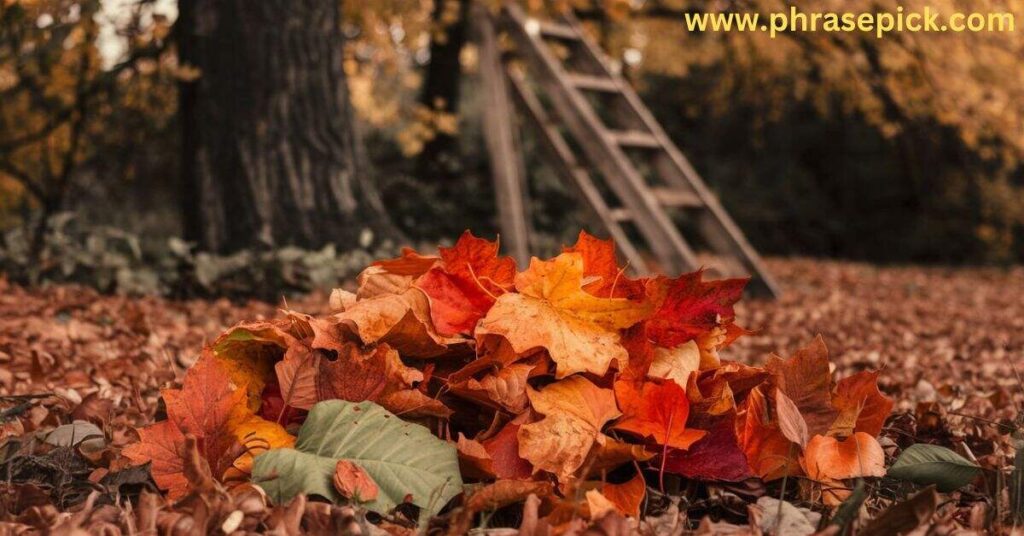Fall brings a world of color and transformation, making it a perfect season for metaphors. With leaves turning red, orange, and gold, autumn offers endless inspiration for vivid descriptions. From rustling winds to crimson carpets, fall’s imagery captures the warmth and beauty of change. Additionally, autumn’s gentle shifts symbolize deeper themes, like letting go and embracing new beginnings.
For writers, these 35 metaphors provide creative ways to bring out fall’s magic and meaning. Whether in poems, stories, or personal reflections, these phrases highlight autumn’s allure. Dive into this collection to find unique expressions that capture the season’s colors, moods, and cozy comforts. Embrace fall’s essence through language, and add charm to any autumn-inspired writing.
Choice 35 Best Metaphors for Fall with Example

1. “Vibrant Foliage”
- Example: Imagine telling a friend, “The park is filled with vibrant foliage bursting in colors.”
- Autumn colors make landscapes look painted, like an artist’s canvas of reds, yellows, and oranges.
2. “Crisp Wind”
- Example: In a weather update: “Today’s crisp wind brings cool freshness to the morning air.”
- The wind feels brisk and refreshing, like nature’s way of cleansing.
3. “Symphony of Leaves”
- Example: In a poem: “The symphony of leaves rustles a soft, natural melody in autumn’s quiet.”
- Leaves play nature’s melody as they dance in the cool breeze.
4. “Crimson Carpets”
- Example: In a nature article: “Forests turn into crimson carpets, covering the ground with red leaves.”
- Fall leaves create a red carpet over the earth, blending beauty and change.
5. “Nighttime Guardian”
- Example: In a story: “Under the stars, the nighttime guardian watches, a quiet sentinel in autumn’s dark.”
- The moon becomes autumn’s protector, watching over chilly nights.
6. “Gentle Goodbye”
- Example: In a farewell card: “This season feels like a gentle goodbye to summer warmth.”
- Fall brings a soft farewell, as warm days gradually leave.
7. “Warm Hug”
- Example: In a cozy gathering invite: “Join us for a fall celebration, a season of warm hugs.”
- Fall’s friendly embrace feels comforting, like a snug sweater on a chilly day.
8. “Hidden Treasures”
- Example: In a scavenger hunt email: “Search for hidden treasures among the fallen leaves.”
- The season holds secret finds like acorns, colorful leaves, and pine cones.
9. “Social Gathering”
- Example: In a local event flyer: “Celebrate the season with a social gathering under autumn’s hues.”
- Fall gatherings bring communities together for seasonal festivities.
10. “Falling Like Rain”
- Example: In a weather alert: “Leaves are falling like rain, covering sidewalks and roads in color.”
- Leaves drift down steadily, resembling a seasonal shower.
11. “Melancholy Song”
- Example: In a reflective poem: “Autumn’s melancholy song speaks of quiet endings and whispered farewells.”
- Fall carries a sorrowful tune, echoing nature’s gentle lull.
12. “Golden Blanket”

- Explanation: Fall leaves create a golden blanket over the ground. As the leaves fall and pile up, they form a warm, golden-colored layer that covers the landscape, similar to how a blanket covers a bed.
- Scenario Example: In a community newsletter: “Take a stroll this weekend and enjoy the golden blanket of leaves in the park.”
- Purpose: This metaphor emphasizes the warmth and richness of autumn’s colors, making it feel cozy and inviting.
13. “Nature’s Quilt”
- Explanation: The leaves, in shades of red, yellow, and orange, create a nature quilt across the ground. The different colors resemble quilted fabric pieces, giving the land a cozy, hand-made appearance.
- Scenario Example: In a letter to a friend: “The park looks like it’s covered in nature’s quilt of colorful leaves.”
- Purpose: This metaphor brings out the patchwork effect of fall foliage, celebrating the unique colors and textures that nature stitches together in autumn.
14. “Whispering Wind”
- Explanation: The whispering wind of fall is a light, gentle breeze that moves softly through the trees. It seems to carry secrets or messages from nature as if the trees and leaves are talking to each other.
- Scenario Example: In a seasonal poem: “The whispering wind tells tales of falling leaves and shorter days.”
- Purpose: This metaphor suggests a gentle, almost magical quality to the autumn wind, inviting readers to listen and reflect on the quiet beauty of the season.
15. “Amber Waves”
- Explanation: Fields and tall grasses take on golden and amber hues in the fall, resembling waves when the wind blows. This image captures the rolling, flowing appearance of grass moving together, almost like the sea.
- Scenario Example: In a harvest festival announcement: “Join us as we celebrate among the amber waves of autumn’s tall grasses.”
- Purpose: This metaphor brings out the richness and depth of autumn’s colors, suggesting that even the simplest landscapes, like fields, hold beauty.
16. “Brisk Embrace”
- Explanation: Fall’s air gives a brisk embrace that feels refreshing, a bit cool but energizing. This kind of hug is chilly yet comforting, like a reminder to appreciate the cozy moments of the season.
- Scenario Example: In a family email about the weather: “Get ready for fall’s brisk embrace and pack some warm sweaters.”
- Purpose: This metaphor describes how fall’s air feels alive, yet welcoming, giving a sense of invigoration while encouraging warmth.
17. “Bounty of Colors”
- Explanation: Trees and plants reveal a bounty of colors in autumn. With leaves turning multiple shades, it’s as if nature is displaying its collection of treasures.
- Scenario Example: In a travel brochure: “Visit the mountains this fall and witness a bounty of colors like no other.”
- Purpose: This metaphor highlights the abundance and variety of colors, likening the season to a rich harvest of hues.
18. “Golden Hour”
- Explanation: In the early evening, as the sun begins to set, autumn light turns everything to a soft golden hour glow. This warm, orange-gold light makes the colors of fall even more vibrant and magical.
- Scenario Example: In a photography invite: “Join us to capture the season’s golden hour glow and the beauty of fall.”
- Purpose: This metaphor draws attention to the warm, calming light that defines autumn sunsets, making everything look picturesque and surreal.
19. “Season of Stillness”
- Explanation: Fall is a season of stillness as nature slows down. The quiet atmosphere after leaves fall and before winter arrives encourages reflection and calm.
- Scenario Example: In a reflective email: “Fall brings a season of stillness, inviting us to pause and enjoy peaceful moments.”
- Purpose: This metaphor emphasizes the calming and tranquil quality of autumn, suggesting that it’s a time for people to relax and prepare.
20. “Tapestry of Time”
- Explanation: Fall leaves create a tapestry of time, where each leaf color represents a stage of nature’s cycle. The layered colors show the progression of the season, much like woven threads in a tapestry.
- Scenario Example: In a literary email: “The forest floor holds a tapestry of time, each leaf a story of change.”
- Purpose: This metaphor symbolizes the depth and beauty of seasonal change, where each leaf represents a unique moment in time.
21. “Rustling Choir”
- Explanation: The leaves form a rustling choir as the wind passes through trees. Together, they sound like soft, natural music, creating an autumn symphony of leaves.
- Scenario Example: In an invitation for a nature walk: “Come hear the rustling choir as we stroll through the autumn woods.”
- Purpose: This metaphor brings out the musical quality of fall, where nature’s sounds create a calming experience.
22. “Painter’s Palette”
- Explanation: Fall colors resemble a painter’s palette filled with warm tones of reds, yellows, oranges, and browns spreading across the landscape.
- Scenario Example: In a greeting card: “Nature turns into a painter’s palette, painting landscapes with brilliant fall colors.”
- Purpose: This metaphor highlights the artistic beauty of fall, as though nature itself is an artist at work.
23. “Falling Tapestry”
- Explanation: Leaves drift down in autumn, creating a falling tapestry that covers the ground in woven beauty.
- Scenario Example: In a community magazine: “Walk beneath the falling tapestry of leaves, each one adding color to the scene.”
- Purpose: This metaphor paints fall as a time of delicate beauty, where the ground becomes an intricate work of art.
24. “Autumn’s Patchwork”
- Explanation: The varied colors of leaves form an autumn patchwork over the land, a multi-colored blanket.
- Scenario Example: In a seasonal guide: “Explore the countryside’s autumn patchwork of colors each tree a unique patch in the landscape.”
- Purpose: This metaphor captures the diversity and richness of fall colors, celebrating their mix like pieces of fabric in a quilt.
25. “Sunset of the Year”
- Explanation: Fall acts as the sunset of the year, a beautiful ending before winter’s darkness.
- Scenario Example: In a newsletter: “Fall, the sunset of the year, reminds us to savor life’s last warm moments.”
- Purpose: This metaphor connects fall with the peaceful close of a day, encouraging reflection on the passing year.
26. “Leaf Lace”
- Explanation: As leaves cover the trees, they create a delicate pattern called leaf lace that looks intricate and beautiful.
- Scenario Example: In a fashion catalog: “Nature’s leaf lace inspires our designs this fall, capturing autumn’s elegance and detail.”
- Purpose: This metaphor draws attention to the grace and delicacy of fall, showing nature as intricate and ornate.
27. “Harvest of Memories”
- Explanation: Fall brings a harvest of memories, as people gather to celebrate and reflect on past moments.
- Scenario Example: In a family reunion invite: “Let’s create a harvest of memories together this fall with loved ones.”
- Purpose: This metaphor connects the season with cherished memories, turning gatherings into lasting bonds and stories.
28. “Mosaic of Leaves”
- Explanation: Leaves form a mosaic on the ground, their shapes and colors like small pieces of art.
- Scenario Example: In an art workshop: “Let’s create a mosaic of leaves to capture fall’s unique beauty.”
- Purpose: This metaphor brings out the artistic arrangement of leaves in autumn, celebrating the season’s detailed patterns.
29. “Season of Transformation”
- Explanation: Fall is a season of transformation, where nature changes rapidly, reminding us of life’s shifting phases.
- Scenario Example: In a personal growth blog: “Embrace autumn, a season of transformation that teaches us the beauty of change.”
- Purpose: This metaphor celebrates change and adaptation, seeing fall as a time of personal and natural evolution.
30. “Earth’s Quilt”
- Explanation: Fall leaves cover the ground like a warm, colorful earth’s quilt, providing a cozy look to landscapes.
- Scenario Example: In a seasonal postcard: “Fall wraps the earth in a quilt of colors, a true autumn masterpiece.”
- Purpose: This metaphor emphasizes the warmth and shelter of fall, connecting it to cozy indoor spaces.
31. “Wind’s Messenger”

- Explanation: The wind acts as fall’s messenger, bringing news of changing weather and colder days ahead.
- Scenario Example: In a local weather report: “Today’s breeze feels like wind’s messenger, hinting at autumn’s arrival.”
- Purpose: This metaphor shows fall as a season of transition and communication, where nature signals change.
32. “Breeze of Change”
- Explanation: The breeze of change signals fall’s arrival, moving the season from summer’s warmth to winter’s cold.
- Scenario Example: In a motivational email: “Let fall’s breeze of change remind you of life’s endless possibilities.”
- Purpose: This metaphor connects fall’s breeze with personal transformation, encouraging adaptation and growth.
33. “Seasonal Symphony”
- Explanation: Fall creates a seasonal symphony of sounds, with leaves crunching and winds whispering their autumn melodies.
- Scenario Example: In a nature program flyer: “Enjoy the seasonal symphony during our autumn walk event.”
- Purpose: This metaphor emphasizes the harmony of sounds in the fall, celebrating the auditory beauty of nature.
34. “Nature’s Farewell Dance”
- Explanation: Leaves perform a farewell dance in the wind, swirling as they drop from trees.
- Scenario Example: In a dance performance: “Our show captures autumn’s farewell dance, celebrating nature’s end-of-season beauty.”
- Purpose: This metaphor connects the graceful end of fall with the beauty of dance, a final celebration of color.
35. “Canopy of Gold”
- Explanation: Fall trees create a canopy of gold, with bright yellow leaves forming a cover overhead.
- Scenario Example: In a photography magazine: “Capture the canopy of gold that lights up trails in autumn.”
- Purpose: This metaphor celebrates the vivid, golden colors of fall trees, creating an umbrella-like effect.
Read More: Sky’s Tears: Exploring Emotional Metaphors For Rain
FAQ’S
What are 12 examples of metaphors?
- Time is a thief – implies that time steals moments from us.
- The world is a stage – which suggests life is like a performance.
- Love is a battlefield – equates love with conflict or struggle.
- He has a heart of stone – which implies a person is emotionally unyielding.
- She’s a walking encyclopedia – suggests someone is very knowledgeable.
- Life is a rollercoaster – describes life’s ups and downs.
- The classroom was a zoo – describes a chaotic classroom.
- Her voice is music to my ears – implies a soothing or pleasing voice.
- The snow is a white blanket – describes snow covering the ground like a blanket.
- He’s a shining star – which implies someone is exceptionally talented or special.
- The mind is a computer – which suggests the mind processes information.
- His words are poison – implies someone’s words are harmful.
What are the metaphors in Things Fall Apart?
- “The falcon cannot hear the falconer” – suggests a loss of control and tradition.
- “Proverbs are the palm oil with which words are eaten” – emphasizes how proverbs enrich conversations like palm oil enriches food.
- The metaphor of the “roaring flame” – describes Okonkwo’s strength and rage, comparing his intense personality to a fire.
- “The clan was like a lizard” – relates to the lizard’s ability to adapt, as the clan attempts to adapt to change.
Are the metaphor for the falling leaves?
The falling leaves are often seen as a metaphor for change, letting go, or endings. Leaves falling from trees represent the passage of time, the inevitability of loss, or preparation for renewal. For example, in poetry or literature, falling leaves can symbolize the end of a cycle, allowing for new growth in the future.
What is a good simile for fall?
- “As colorful as a painter’s palette” – highlights the bright and varied colors of autumn.
- “As crisp as an apple” – captures the refreshing, cool air typical of fall.
- “Leaves fall like confetti at a parade” – evokes the joy and beauty of autumn leaves.
- “Cool as the other side of the pillow” – describes the pleasant coolness of fall.
- “As cozy as a warm blanket” – brings out fall’s comforting atmosphere.
- “Leaves dance like ballerinas in the wind” – captures the graceful motion of falling leaves.
- “As golden as honey” – reflects the golden hues of fall foliage.
- “Brisk as a mountain breeze” – emphasizes the refreshing air of the season.
- “Falling like a soft, gentle rain” – suggests the quiet descent of leaves.
- “As peaceful as a quiet lake” – brings out fall’s calm and reflective mood.
Read More: 41 Metaphors for Fear
Conclusion
fall’s metaphors beautifully capture the season’s warmth, change, and natural splendor. These 35 expressions offer vivid ways to convey autumn’s essence, from leaf-strewn paths to the brisk winds of October. Moreover, each metaphor brings out the reflective, cozy mood unique to this time of year. Whether describing colorful foliage or cool breezes, these phrases add depth to any writing or conversation about fall.
Use them to express gratitude, renewal, or quiet reflection as the season changes. Altogether, these metaphors showcase fall’s richness and invite readers to appreciate its beauty in fresh ways. Let these words highlight autumn’s magic and make your descriptions as vibrant as the season itself.

James Smith is an experienced blogger at PhrasePick, where he shares his expertise in English grammar and figurative language. With a passion for simplifying complex topics, James creates engaging content that helps readers master the nuances of the English language.





